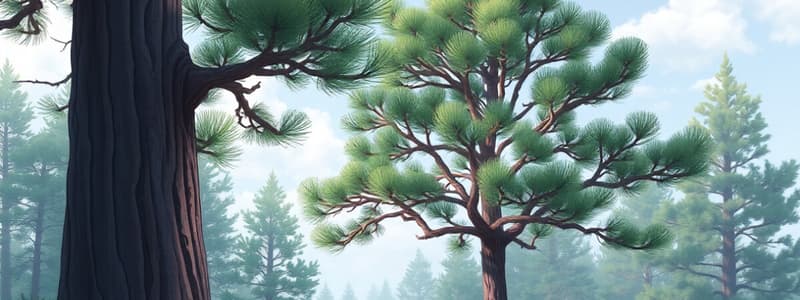Podcast
Questions and Answers
What is the scientific name for the ponderosa pine?
What is the scientific name for the ponderosa pine?
- Pseudotsuga menziesii
- Juniperus scopulorum
- Pinus ponderosa (correct)
- Pinus sylvestris
Which of the following is a common name for 'Juniperus communis'?
Which of the following is a common name for 'Juniperus communis'?
- Mountain mahogany
- Choke cherry
- Rocky Mountain juniper
- Common juniper (correct)
Which species is known as choke cherry?
Which species is known as choke cherry?
- Rosa spp.
- Amelanchier alnifolia
- Prunus virginiana (correct)
- Prunus serotina
What is the scientific name for the mountain mahogany?
What is the scientific name for the mountain mahogany?
Which of the following is NOT part of the Ponderosa Pine eco-system?
Which of the following is NOT part of the Ponderosa Pine eco-system?
What species is referred to as sticky/curly cup gum weed?
What species is referred to as sticky/curly cup gum weed?
Which of the following plants is known as blazing star?
Which of the following plants is known as blazing star?
What is the common name for 'Yucca glauca'?
What is the common name for 'Yucca glauca'?
Which of the following species has the scientific name 'Pseudotsuga menziesii'?
Which of the following species has the scientific name 'Pseudotsuga menziesii'?
Which plant is known for its role as a prairie sage in the ponderosa pine ecosystem?
Which plant is known for its role as a prairie sage in the ponderosa pine ecosystem?
What is the common name for 'Rhus trilobata'?
What is the common name for 'Rhus trilobata'?
Which species is known as 'Opuntia fragilis'?
Which species is known as 'Opuntia fragilis'?
Which of these plants is a member of the Rosaceae family found in the ecosystem?
Which of these plants is a member of the Rosaceae family found in the ecosystem?
What is the common name for the species 'Cercocarpus montanus'?
What is the common name for the species 'Cercocarpus montanus'?
Which of the following plants is characterized as a goldenrod species in this ecosystem?
Which of the following plants is characterized as a goldenrod species in this ecosystem?
Which plant species is identified as 'Ericameria nauseosa'?
Which plant species is identified as 'Ericameria nauseosa'?
Study Notes
Ponderosa Pine Eco-System
- Pinus ponderosa (Ponderosa Pine): A key species in this ecosystem, known for its tall stature and long needles.
- Juniperus scopulorum (Rocky Mountain Juniper): A hardy shrub often found in rocky areas, valuable for erosion control and wildlife habitat.
- Prunus virginiana (Choke Cherry): Produces clusters of small cherries, important for birds and mammals but can be toxic if consumed in large quantities.
- Pseudotsuga menziesii (Douglas-fir): A significant timber species known for its resilience and economic value in forestry.
- Cercocarpus montanus (Mountain Mahogany): Found in mountainous areas, known for its hard wood and as a source of food for wildlife.
- Ericameria nauseosa (Rabbitbrush): A drought-tolerant shrub, blooming yellow flowers that attract pollinators.
- Juniperus communis (Common Juniper): A versatile plant used for medicinal purposes and as a habitat for various species.
- Yucca glauca (Narrow-leaved Yucca): A perennial succulent known for its striking flowers and role in desert ecosystems.
- Rosa spp. (Rose): Various species contribute to biodiversity, providing food and shelter for wildlife.
- Symphoricarpos albus (Snowberry): A low shrub with white berries, an important food source for birds during winter.
- Solidago sp. (Goldenrod): Popular for its bright yellow flowers, it plays a role in supporting pollinator populations.
- Acer glabrum (Rocky Mountain Maple): A small tree valued for its decorative foliage and role in streamside ecosystems.
- Artemisia ludoviciana (Western Mugwort/Prairie Sage): Recognized for its aroma and traditional medicinal uses.
- Amelanchier alnifolia (Serviceberry/Saskatoon): Produces sweet berries, enjoyed by wildlife and humans alike.
- Artemisia frigida (Prairie Sagewort): A perennial herb, known for its resistance to drought.
- Rhus trilobata (Skunkbrush): A shrub with trifoliate leaves, often found in disturbed areas and valued for its ecological role.
- Liatris punctata (Blazing Star): A native perennial with striking purple flowers, attracting numerous insect pollinators.
- Grindelia squarrosa (Sticky/Curly Cup Gumweed): Noted for its sticky leaves and used in traditional medicine.
- Opuntia fragilis (Prickly-Pear Cactus): A cactus that thrives in arid environments, providing food for wildlife and humans.
- Ribes cereum (Wax Currant): A shrub producing small edible berries, an important food source for birds.
Ponderosa Pine Eco-System
- Pinus ponderosa (Ponderosa Pine): A key species in this ecosystem, known for its tall stature and long needles.
- Juniperus scopulorum (Rocky Mountain Juniper): A hardy shrub often found in rocky areas, valuable for erosion control and wildlife habitat.
- Prunus virginiana (Choke Cherry): Produces clusters of small cherries, important for birds and mammals but can be toxic if consumed in large quantities.
- Pseudotsuga menziesii (Douglas-fir): A significant timber species known for its resilience and economic value in forestry.
- Cercocarpus montanus (Mountain Mahogany): Found in mountainous areas, known for its hard wood and as a source of food for wildlife.
- Ericameria nauseosa (Rabbitbrush): A drought-tolerant shrub, blooming yellow flowers that attract pollinators.
- Juniperus communis (Common Juniper): A versatile plant used for medicinal purposes and as a habitat for various species.
- Yucca glauca (Narrow-leaved Yucca): A perennial succulent known for its striking flowers and role in desert ecosystems.
- Rosa spp. (Rose): Various species contribute to biodiversity, providing food and shelter for wildlife.
- Symphoricarpos albus (Snowberry): A low shrub with white berries, an important food source for birds during winter.
- Solidago sp. (Goldenrod): Popular for its bright yellow flowers, it plays a role in supporting pollinator populations.
- Acer glabrum (Rocky Mountain Maple): A small tree valued for its decorative foliage and role in streamside ecosystems.
- Artemisia ludoviciana (Western Mugwort/Prairie Sage): Recognized for its aroma and traditional medicinal uses.
- Amelanchier alnifolia (Serviceberry/Saskatoon): Produces sweet berries, enjoyed by wildlife and humans alike.
- Artemisia frigida (Prairie Sagewort): A perennial herb, known for its resistance to drought.
- Rhus trilobata (Skunkbrush): A shrub with trifoliate leaves, often found in disturbed areas and valued for its ecological role.
- Liatris punctata (Blazing Star): A native perennial with striking purple flowers, attracting numerous insect pollinators.
- Grindelia squarrosa (Sticky/Curly Cup Gumweed): Noted for its sticky leaves and used in traditional medicine.
- Opuntia fragilis (Prickly-Pear Cactus): A cactus that thrives in arid environments, providing food for wildlife and humans.
- Ribes cereum (Wax Currant): A shrub producing small edible berries, an important food source for birds.
Studying That Suits You
Use AI to generate personalized quizzes and flashcards to suit your learning preferences.
Related Documents
Description
Test your knowledge about the Ponderosa Pine eco-system in this dendrology quiz. Identify the scientific names and common names of various species found within this unique environment. Perfect for students and enthusiasts of botany and ecology.




